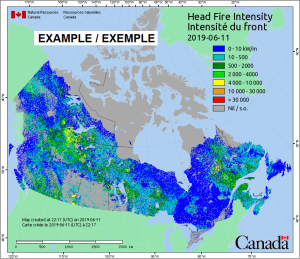CWFIS Datamart
Metadata

Canadian Forest Fire Behavior Prediction (FBP) System - Daily Maps
Description
The Canadian Forest Fire Behavior Prediction (FBP) System provides quantitative estimates of potential head fire spread rate, fuel consumption, and fire intensity, as well as fire descriptions. With the aid of an elliptical fire growth model, the FBP system gives estimates of fire area, perimeter, perimeter growth rate, and fire behavior at the head, flanks, and back of a fire.
• Rate of Spread (ROS) is the predicted speed of the fire at the front or head of the fire (where the fire moves fastest) and takes into account both crowning and spotting. It is measured in meters per minute and is based on the Fuel Type, Initial Spread Index, Buildup Index, and several fuel-specific parameters such as phenological state (leafless or green) in deciduous trees, crown base height in coniferous trees, and percent curing in grasses.
• Total Fuel Consumption (TFC) is the predicted weight of fuel consumed by the fire both on the forest floor and in the crowns of the trees. It is measured in kilograms per square meter of ground surface and is based on Foliar Moisture Content, Surface Fuel Consumption, and Rate of Spread.
• Head Fire Intensity (HFI) is the predicted intensity, or energy output, of the fire at the front or head of the fire. It has become one of the standard gauges by which fire managers estimate the difficulty of controlling a fire and select appropriate suppression methods. It is measured in kilowatts per meter of fire front and is based on the Rate of Spread and the Total Fuel Consumption.
• Crown Fraction Burned (CFB) is the predicted fraction of the tree crowns consumed by the fire. It is based on Buildup Index, Foliar Moisture Content, Surface Fuel Consumption, and Rate of Spread.
• Fire Type (FT) provides a general description of the fire. It is based on the Crown Fraction Burned (CFB). If the CFB is less than 0.1 (10%), then the fire is a surface fire. If the CFB is 0.9 (90%) or more, the fire is a continuous crown fire. If the CFB is between 0.1 and 0.9, the fire is an intermittent crown fire.
Supplemental Information
Canadian Forest Fire Behavior Prediction (FBP) System :Data Sources and Methods for Daily Maps :
Fuel Types (view FBP fuel types map - https://cwfis.cfs.nrcan.gc.ca/background/maps/fbpft ):
The map of FBP fuel types was derived primarily from forest attribute data (Beaudoin et al 2014) based on satellite imagery acquired by NASA's MODIS (Moderate Resolution Imaging Spectroradiometer) sensors. Fuel types were assigned based on vegetation type, tree species, crown closure, stand height, and other attributes.
This fuels map gives only a general idea of the fuel types present and is not suitable for operational fire management because of the moderate resolution and limited scope of the input data.
Daily Grid Production:
The FBP System outputs include the Foliar Moisture Content and measures for potential Surface Fuel Consumption, Rate of Spread, Total Fuel Consumption, Head Fire Intensity, and Crown Fraction Burned. Each of these outputs is calculated on a cell-by-cell basis, using the weather, Fire Weather Index (FWI), and fuel type grids as inputs. Production of the weather and FWI grids is described under Data Sources and Methods for Daily Maps in the FWI System - https://cwfis.cfs.nrcan.gc.ca/background/dsm/fwi .
Reference:
Beaudoin, A.; Bernier, P. Y.; Guindon, L.; Villemaire, P.: Guo, X.J.; Stinson, G.; Bergeron, T.; Magnussen, S.; Hall, R.J. 2014. Mapping attributes of Canada’s forests at moderate resolution through k NN and MODIS imagery. Canadian Journal of Forest Research 44 (5): 521–532.
Licenses
Open Government Licence - Canada (http://open.canada.ca/en/open-government-licence-canada)
When the Data is displayed, in print, electronically, or otherwise, the source (i.e., Natural Resources Canada) must be acknowledged along with the following citation: Canadian Forest Service. 2022. Canadian Wildland Fire Information System (CWFIS), Natural Resources Canada, Canadian Forest Service, Northern Forestry Centre, Edmonton, Alberta. http://cwfis.cfs.nrcan.gc.ca.
Data Resources
FBP - Current Conditions (TIFF)
For additional information, please see the metadata included with the data itself.